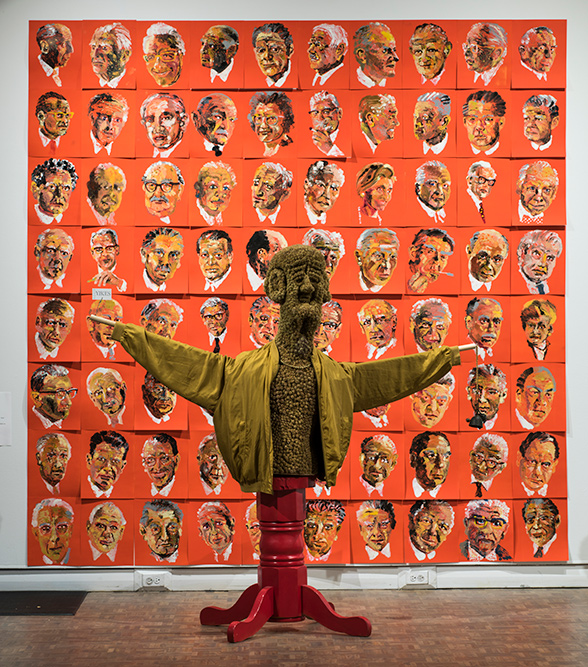Scarecrow Among the Chancellors stations a weathered survivor before a monument of top dogs.
The monotyped faces on the wall are derived from a 1967 book, Swiridoff: Portraits of German Political and Economic Life, of photographs of mid-century politicians and business figures of the postwar economic miracle –Wirtschaftswunder–era. These are the faces of some of the most profoundly focused and accomplished adults in the public sphere of their time. The service-staff working stiff scarecrow is experiencing a moment of status vertigo, uncertain whether his life has borne sufficient fruit in comparison. This is expressed in the manner of the scientist Wile E. Coyote, who, having stepped off a cliff, saunters blithely on until he becomes aware of his circumstance, at which point he articulates his dread as the law of falling bodies reasserts itself.
Has one grown old without growing up? For artists, as for everyone, each instant of one’s life is a moral minefield that turns us either into Isaiah Berlin’s hedgehogs, who view the world through the lens of a single defining idea, or foxes, who draw on a wide variety of experiences and for whom the world cannot be boiled down to a single idea. For me art’s first relevance is its heuristic value – I always want the work to be a little smarter than I am. To invent and construct ideas in concrete form is also a way of constructing one’s self. The promise of a lifetime’s labour is the hope of a ‘late style’: that is, an unprecedented, personal voice. Titian, in his late paintings, used as little paint as is humanly possible to conjure a felt reality. Beethoven, in his last piano sonata, No.32, Op. 111, effectively anticipates boogie-woogie jazz in 1822. At some point in an artist’s life, perhaps one has prepared oneself by giving to art, in the form of work and thought, sufficiently that one can now take from art ideas and forms which are beyond one’s grasp.
Based in Cape Breton, Onni Nordman is the son of Finnish immigrants who moved to Canada in 1951. Educated at the Nova Scotia School of Art and Design, Halifax, he returned to Sydney in 1995. Nordman’s practice is rooted in painting, but his highly individual iconography also extends to collage, video, sculpture and printmaking. Presently, he teaches oil painting at the Cape Breton Centre for Craft and Design while continuing to exhibit in solo and group shows both nationally and internationally. Most recently Nordman’s work has appeared at Finlandia University Art Gallery, Hancock, Michigan, Galleria-Artika, Helsinki, Finland, Eastern Edge, St. John’s, Newfoundland, and Pasinger Fabrik Kultur- und Bürgerzentrum, Munich, Germany. Nordman’s work is reproduced on multiple book covers and held in public and private collections in Canada, USA, Australia, Europe and the Middle East.
Description of the Artwork
Audio Transcript
This piece is called ‘Scarecrow Among the Chancellors’.
The scarecrow is built of seed pods from the burdock plant. Go ahead and touch him. He’s like a Buckingham Palace guard, it’s part of his job to put up with it. How many burrs? I’ll save you time counting. There are 25,500 burrs. Each one stands for a day, a day in the life. So 25,500 is seventy years, your threescore-and-ten. A scarecrow is essentially a security guard, but at that age he’s known as a commissionaire.
The burrs were picked in the first week of August in that time-window of about a week just before they blossom with purple flowers. They were green when the burr man was built, but now they’re sepia brown, like an old photograph. He’s wearing a mustard-coloured silk jacket. You can soothe your fingers on the silk after touching his prickly flesh. He’s wearing a gold chain around his neck because he has something of the fancy man about him.
At the end of his right scarecrow-stick arm he’s holding a business card reading “Yikes”, and at the end of his left hand there dangle three old bells. When you ring them, they all sound together. Individually, their sound is rather sweet, but together they sort of cancel each other out.
The burr man’s legs are a very solid set of bright red table legs. It makes him very stable, he couldn’t fall over even in a high wind. He’s not as stable up top though, he’s somewhat frail. So it wouldn’t be such a good idea to give him a hug or slap him on the back or anything like that. He’s a scarecrow after all, so he’s working.
That red of the legs is the same colour as the background of the eighty portraits on the wall. The images of the chancellors –they’re actually all sorts of older German politicians and businessmen –and a few women– are monotyped, which is to say, they were painted on a smooth plexiglass surface that really allows you to push the paint around as frictionlessly as if you were ice-skating. Then the image is transferred from the plexiglass to the paper under pressure. This makes the paint spread out in not entirely predictable ways, so every image is a surprise. If you run your fingers gently over the faces, you’ll feel the interesting crusty surface that results when you pull two surfaces of wet paint apart. In biology this called a hydroid pattern. Painters spend a lot of thought adjusting the texture of their surfaces, because they love the material, but in most museums and galleries you can’t go up and touch the paintings. But here, you’re encouraged to do just that.
Among the Chancellors
Draped burdock sculpture with 80 monotypes (touchable sculpture) Sculpture height: 1.82 m Monotypes installed: 3.04 x 3.04 m, 2017







